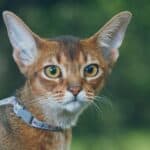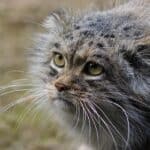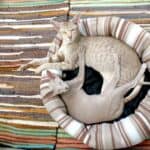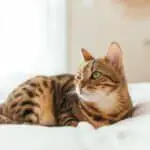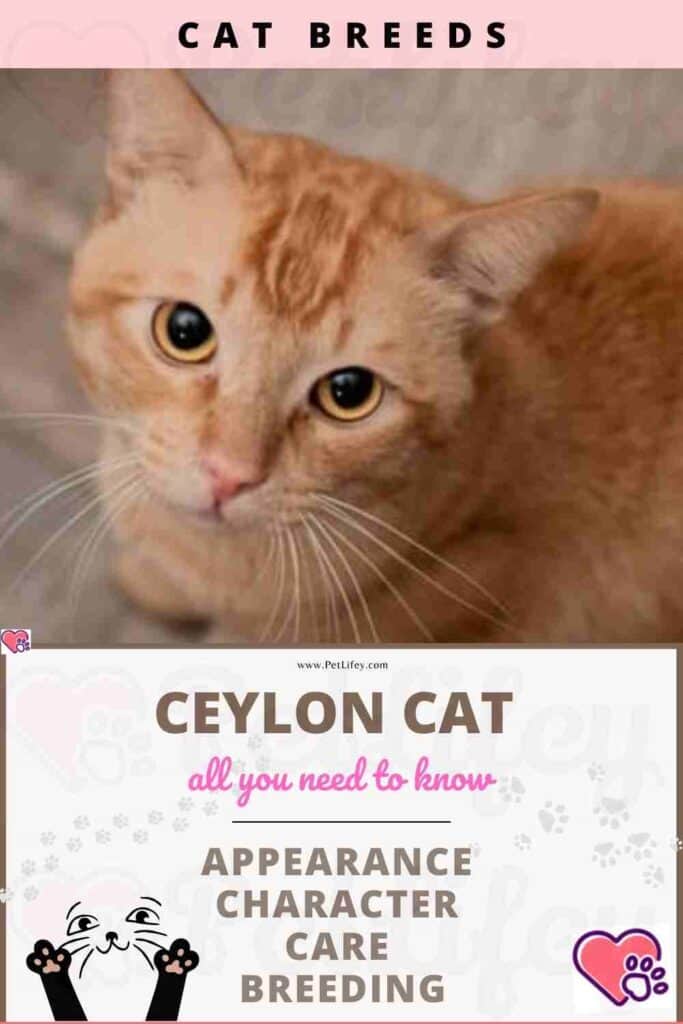
When one thinks of the Ceylon cat, the first adjectives that come to mind are “bright”, “small”, “soft” and “agile”. And no word would be better to describe it! The people who choose him are struck by the dreamy expression that can be read in his eyes, very expressive and brilliant.
It may seem sad and thoughtful, but those who have the opportunity to meet them quickly realize that the expression can be misleading: lively and mischievous, it considers everyone to be their playmates. very rare breed of cat.
The origins of the Ceylon Cat
Enlightened amateurs agree that the Ceylon cat, like all the cats that inhabit the coasts of the Indian Ocean, has its origins in Felis chaus, the ancient Egyptian cat. The Ceylon breed originates from the island of Sri Lanka, where it developed through a series of crosses of local cats and cats that came from the mainland on board ships.
It arrived in Europe in 1982; in 1988, a few specimens of Ceylon Cat were presented for the first time to a commission of judges who invited the Ceylon Cat Club to continue selection work for the recognition of this new breed.
In October of the same year, the members of the International Commission of FIF Judges drew up a report which authorized the registration of the Ceylon breed in the Book of Origins, which was effectively done in January 1989. It is most prevalent in Sri Lanka and very few in Europe.
Appearance of the Ceylon Cat
The body, of medium height, is short and low, with light bone structure and compact musculature, supported by not very long legs and small, round feet.
The head, well proportioned to the body, has round cheeks and prominent cheekbones; the forehead and the skull are slightly flattened.
The nose is quite short and the chin weak and slender. The ears, set high on the head, are large and open at the base.
The eyes, rather large, have the upper rim almond-shaped and the lower rounded; the cat keeps them wide open, giving it a dreamy expression. Their color varies from yellow to green.
The throat and chest are of medium proportions and appear strong, without being too stocky, while the neck is not very slender and of medium length. The tail is relatively short, wider at the base and gradually tapering towards the round tip.
The coat has a short coat and adherent to the body, with a fine and silky texture.
Coat color of the Ceylon Cat
The main color is ‘manila’ (ash) with black ticking on a light base and shades varying from pearlescent to warm cinnamon and apricot. All other colors may show similar shades. Also popular are the colors: red, blue, cream and their corresponding varieties of turtle scales.
The Ceylon cat can have three coat patterns:
Bentota (ticked mackerel tabby, blotched tabby or spotted tabbly), where the coat presents a uniform ticking (alternation of light bands and dark bands on each hair) on the back, shoulders and sides.
The design on the forehead is called “cobra”. There are one or two open or closed necklaces on the neck and rings on the tail. The abdomen and limbs show a tabby design; on the part close to the limbs (forearms and flat of the thighs) there may be tiny spots.
Depending on the season, some ghost spots may appear on the evenly marked areas of the back
– Footwear (wild or natural ticked) which provides for a uniformly marked dress. On the ends there are more or less obvious traces of tabby design, matching the shade of the dress: in general, there are no rings on the tail
– Continental (tabby) which presents a uniformly tabby dress with all its designs: spotted, mackerel and blotched.
The character of the Ceylon Cat
Copies of this breed are very daring and lively: endowed with a sociable and friendly character, they are not afraid of the man, to whom they tenderly attach themselves.
The Ceylon cat is an agile hunter; small animals are his favourite prey. The touch of originality that makes it special and sets it apart from other felines is its pronounced taste for coconut pulp, a fruit very common on its native island.
Hug:
Sociable and friendly towards humans, this cat is more or less cuddly. Letting them take the initiative in contacting is always a good idea.
Playful:
The playful character of this feline is one of the characteristics of the breed. It will therefore be necessary to be able to offer him daily gaming sessions.
Calm:
Even if it can be very active, the Sri Lankan cat also needs phases of recovery during which it needs to be calm, to respect his sometimes independent nature.
Intelligent:
This cat will know how to respect its needs, which are as much a presence and availability as a certain independence.
Fearful / suspicious of strangers:
It is extremely social. However, individual differences in temperament are present.
Independent:
It is independent, in the sense that it will have their own habits and routines of life. However, this cat needs attention. It prefers to have a human presence who will know how to make himself available. It will not appreciate being alone for long days and will be more suitable for someone who works from home or who is not working.
Behavior of the Ceylon Cat
Talkative:
The Sri Lankan cat can be talkative to achieve his goals.
Greedy / gluttonous:
It is not known to be particularly greedy, which does not prevent them from offering its a balanced diet.
Need for exercise:
Their playful character makes them very active. If this feline must live indoors, a cat tree is recommended, as well as daily play sessions.
The Ceylon cat is also a very good hunter, due to its island origins: not always domesticated, it had to feed itself on small rodents.
Runaway:
Their taste for stalking prey can cause them to stray from the house. If it can have free access to the outside, it is therefore better to offer them a secure space in the garden if you live near busy roads.
Compatibility of the Ceylon Cat with other animals
Ceylon and Dogs:
Very sociable by nature, it is known to adapt easily to its environment, including the presence of dogs that would come to share its routine. However, individual differences are present.
Ceylon and Other Cats:
Very sociable by nature, the Sri Lankan cat adapts very well to feline companions, ensuring that everyone has their own space.
Ceylon and Children:
Very sociable by nature, it can easily adapt to children’s games, as long as they are done with respect for the animal. However, individual differences are present.
Ceylon and the Elderly:
Above all, it will appreciate the availability shown by a person of a certain age, provided that she agrees to play with him!
Price of the Ceylon Cat
On average, the purchase price of a kitten in breeding is 1663.69 USD. This average masks the strong price disparities, from 1200 USD to 3000 USD (scarcity requires), depending on age or sex.
For the monthly budget, it will take an average of 50 USD / month to meet his needs, by offering him a quality diet and making sure to keep him in good health.
Maintenance of the Ceylon Cat
Grooming:
The maintenance of his coat is easy since their short coat does not require daily brushing.
Hair loss:
Its short coat and the virtual absence of undercoat do not make it a cat that leaves its hair everywhere!
Food of the Ceylon Cat
A balanced diet will suit them perfectly, which it will decorate with preys if it has the opportunity.
On its island of origin, the Sri Lankan cat is little domesticated. It is therefore completely autonomous in terms of food, feeding exclusively on the product of its hunting. A household diet should therefore be very rich in protein.
Health of the Ceylon Cat
Life expectancy:
On average, Ceylon has a life expectancy of around 14 to 16 years.
Resistant / robust:
Due to its origins, this cat is more suited to heat than to cold.
Tendency to gain weight:
His very active temperament makes him exercise a lot. This feline therefore does not tend to be overweight.
Frequent diseases:
The Ceylon is of robust health so there is no pathology specific to its breed. However, he could develop the known pathologies of the domestic cat. If he has access to the outdoors, it might be preferable for him to be vaccinated against infectious diseases such as Coryza , Leucosis , Rabies (in countries where rabies is present) and Typhus .
It also has a certain fragility to periodontal disease ( gingivitis and tartar ). Prevention and dental care will be recommended
Reproduction:
No crossing is allowed.
Good to know
To make a lifelong friend, treat him or her from time to time with coconut pulp: it’s his sweet tooth!


